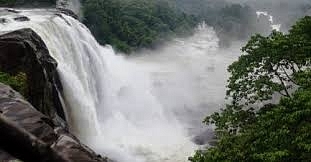Politics
Too Little Too late: Kerala Attempts To Revive Hydel Projects As People Prepare For Shutdowns
- The Kerala government and the KSEBL have to find an immediate solution to the instability that plagues the power sector in the state.
- Proposing new hydel power projects and piggybacking on centrally sponsored renewable energy schemes are just not enough.

Athirapally hydel project
The Kerala government recently decided to revive the controversial Athirapally hydroelectric project with a view to increasing power production and assuage the power deficit within the state.
The project however, remains highly controversial. Not only is the project cost, which increased from an initial Rs 500 crore to Rs 1,500 crore, a problem, but also concerns for the environment and tribal welfare. The project has always run afoul of the tribals in the area, as well as environmentalists, who say it poses a threat to the state bird, the great hornbill.
The Athirappilly hydel project, which was first proposed in 1979, has been rife with problems, yet the government has decided to go ahead, despite internal opposition in the form of Communist Party of India. Why is the government insisting on this project, which has faced almost near constant opposition?
The answer lies in the inability of the KSEBL (Kerala State Electricity Board Limited), the sole generator, transmitter and distributor of electricity, to source electricity from within the state. KSEBL has only been able to source a mere 30 per cent of its electricity from within the state, with the production from the Idduki Dam amounting to a third of the total 6700+ million units of electricity produced. In other words, the Idduki reservoir levels determine whether Kerala opts for power shutdowns or not. The total contribution of hydel projects to the state grid is more than 99 per cent - with only about a 100 MW being sourced from other thermal and renewable Energy.
The high dependency on hydel power projects results in the shortage of power during the summer months, as the reservoirs are rain-fed. Just this year, electricity production has declined by 45 per cent, as a result of the hydel reservoirs receiving only 55 per cent inflow. This saga of deficit in reservoir and reduction in power generation has led to fears of repeated power shutdowns summer after summer. This, it should be mentioned, is when the state is heading for a 100 per cent electrification by 31 March, according to the Electricity Minister.
The cynic in me would quip that there is no use of 100 per cent electrification if there is no electricity to be used. An unreliable grid is as good as a non-existent one.
This leads automatically to the question of adding capacity to the grid, and this is where the state is a miserable failure. Kerala has been left far behind other states in adding additional capacity to its grid; Kerala has added a mere 260 MW in a 10 year period of 2005-2015. This has forced the state to rely almost entirely on power exchanges, as well as sourcing it from other states. This, of course, has led to an acute revenue deficit for the KSEBL. The company posted an official net loss of Rs 1,272 crores for the financial year ending 2015. The current estimates also show that the board will suffer a loss of around Rs 700 crore this year as well.
While the state has led the rest of the country in the arena of electrification, this issue remains a matter of serious concern. The state government is proposing to tide over these difficulties by proposing a series of new hydel power projects and increasing energy efficiency through awareness programmes, as well as piggybacking on centrally sponsored renewable energy schemes. This, however, is no viable solution to the issue in the long term. The deficit that the KSEB has to make up for, with the increasing demand for power, is too high.
The Athirapally hydel project - the largest of the proposed projects - adds a mere 163 MW to the grid, which is too little too late. The state government's proposal will in no way alleviate this crisis in the long term. The KSEBL, on the other hand, has proposed an increase in the tariff charges so as to decrease the revenue deficit, which has been postponed (again) by the Kerala State Electricity Regulatory Commission.
The Kerala government and the KSEBL have to find an immediate solution to the instability that plagues the power sector in the state. Right now, the solutions proposed are nothing but an eye-wash that will not dispel the fear of power shutdowns in the minds of the people of the state.
Support Swarajya's 50 Ground Reports Project & Sponsor A Story
Every general election Swarajya does a 50 ground reports project.
Aimed only at serious readers and those who appreciate the nuances of political undercurrents, the project provides a sense of India's electoral landscape. As you know, these reports are produced after considerable investment of travel, time and effort on the ground.
This time too we've kicked off the project in style and have covered over 30 constituencies already. If you're someone who appreciates such work and have enjoyed our coverage please consider sponsoring a ground report for just Rs 2999 to Rs 19,999 - it goes a long way in helping us produce more quality reportage.
You can also back this project by becoming a subscriber for as little as Rs 999 - so do click on this links and choose a plan that suits you and back us.
Click below to contribute.
Latest